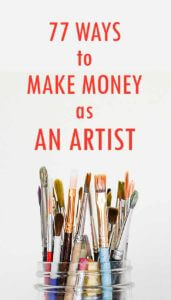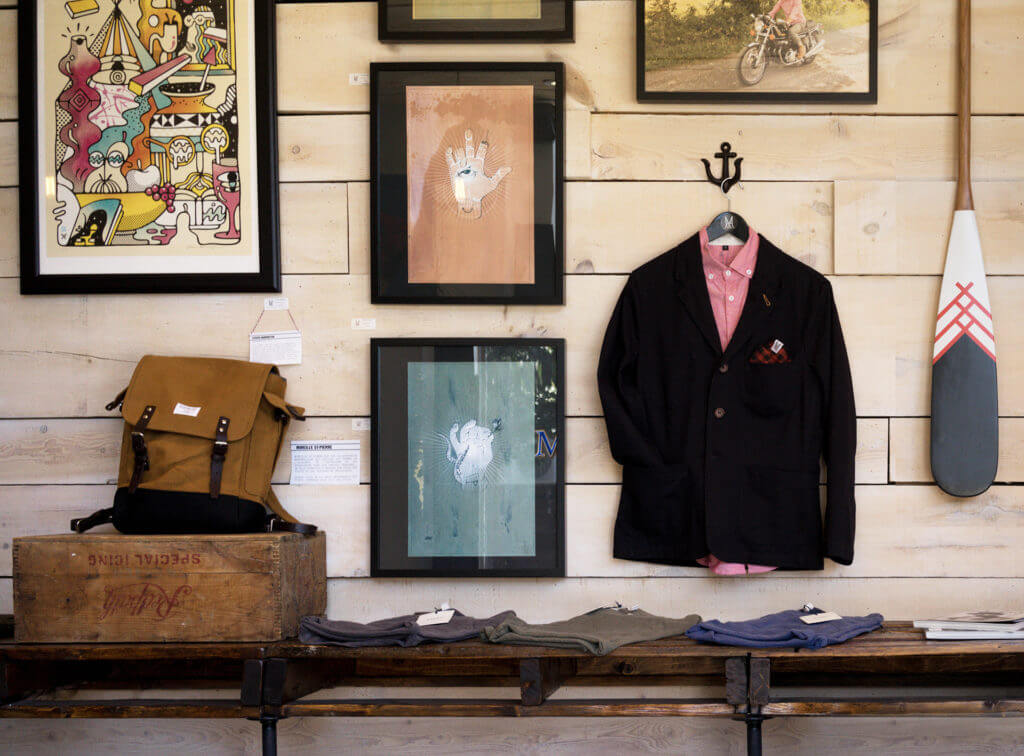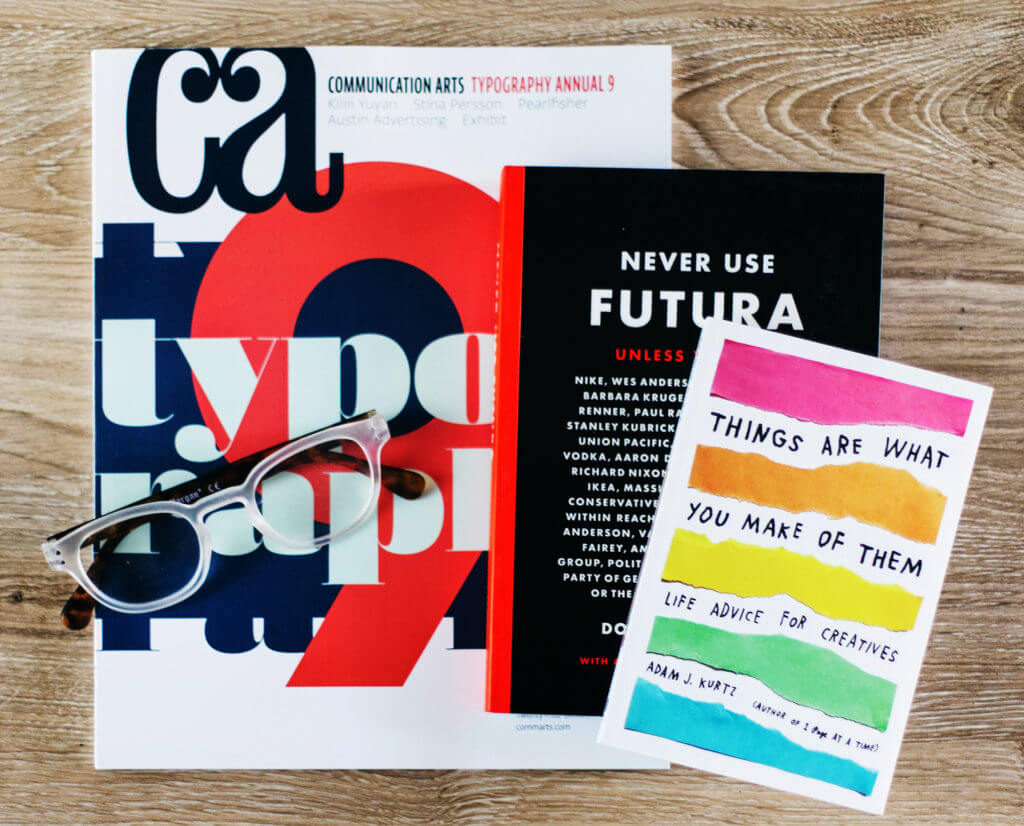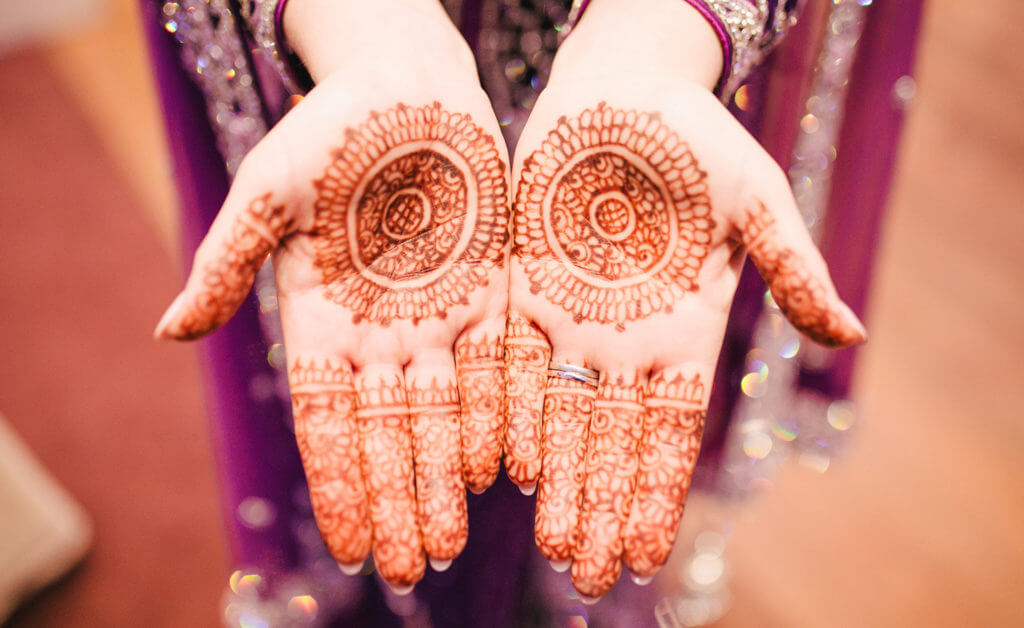When most artists think about making money with their art, three things immediately come to mind: selling originals, doing commission work, and selling prints.
Some artists might also think of teaching, or design jobs.
But are those the only ways to make money as an artist?
Absolutely not!
In fact, we’ve put together a huge list of 77 ways you could turn your artistic skills into income. Not all of these ideas apply to every artist, but most of them will at least be intriguing to those of us with a creative mindset. Let’s get started!
77 ways to make money as an artist
This massive list is divided into four main categories:
• Generating income from selling art you create
• Teaching art to others
• Artistic careers & professions
• Miscellaneous creative work
. . . and some of those also have subcategories as well. :)
Feel free to jump to the category that interests you most (just click any of the links above) or keep reading to see them all!
Making money by selling art
Portraiture
1. Commissioned portrait artist
The artist is hired by a client to create a likeness of a family member, or a portrait of a pet or favorite animal. Portrait work can also include creating portraits of houses or properties, or even a specific landscape, seascape, or other type of scenery.
2. Caricatures and speed drawing artist
An artist sits at a booth and creates quick drawings of customers while they wait, usually 30 minutes or less. Generally much less expensive than a full-scale portrait as described above. This type of portrait work can be very lucrative for the artist who has excellent drawing and observation skills, the ability to work under pressure (with people watching) and good people skills.
Original art
3. Selling in art galleries
The first places we all think of is exhibiting with an art gallery, either as a regular exhibitor or a guest exhibitor. Includes professional galleries, special interest galleries, and membership galleries.
4. Selling at art fairs
Art fairs are a great place to get your work in front of the public. Some of the larger art fairs attract visitors from across the United States and the world. If you can find an art fair catering to your style of art, all the better.
3. Selling online, through your own art website
In these days of technology, any artist who is serious about selling art needs a website. Social media is all the rage right now, but you still need an art website to showcase your work, give visitors the opportunity to buy directly from you, and display easy-to-find contact information.
4. Selling at non-art commercial venues
Is your art equine-related? Maybe you specialize in canine-related arts, or landscapes or florals. Have you ever thought about getting a booth at a horse show, dog show, or home and garden convention? Trade shows like these aren’t traditional venues for artists, but they can be excellent places to display your work, if they fit your subject matter!
5. Selling at coffee shops, restaurants, boutique stores. . .
Many cafes, restaurants, and small retail stores welcome original artwork to decorate their businesses, especially if they cater to tourists. Visit the location first, see what type of traffic they have and how the artwork is displayed. If it looks promising, speak to someone who can tell you how sales are handled, what the business charges (if anything) for handling sales, and so on.
(For more info on how to do this, read How to Sell Art Locally at Coffee Shops.)
6. Selling during an open studio event
Some artists have their best sales during open studio events, during which the public is invited to visit the studio, see works in progress, and purchase or commission art. Provide reproduced items such as greeting cards, giclees, and merchandise (see below) to improve revenue.
Selling fine art reproductions, or items printed with your art
7. Through an online print-on-demand services
RedBubble and Imagekind are two print-on-demand companies that produce all types of merchandise from your art. Open an account, upload images, decide what you want to sell (clothing, stationary, reproductions, etc.) and the company does the rest. POD services typically charge a base fee for the product on which images are printed, and you decide your markup (the amount you get for each sale.)
8. Printing your items yourself, then selling direct to buyers
Modern day printers allow you to create high-quality reproductions of your work on paper, canvas, and other supports. Some also allow you to print decals for use on ceramic items.
9. Licensing your art with a licensing agent
Licensing agents contract with artists for the rights to market their images to vendors. Licensed images are often used for such wide-ranging things as fabric design, interior decorating items, calendars, and many other products.
10. Wholesaling to home stores and retailers
Pay a printer to print your images, keep your own inventory, and deliver stock directly to retail outlets in your area. Look for shops and stores that cater to the same market your art fits into. Some may also be willing to carry your originals as well.
Photographer
11. Event photographer
Photograph special events such as weddings, graduations, and local sporting or other events.
12. Portrait photographer
Take your own reference photos for pet or human portraits? Then you may already be equipped to offer portrait photography as a standalone or add-on service.
13. Newspaper or magazine photographer
Photograph newsworthy or special events for the local newspaper or your favorite magazines. Many pay by the image.
14. Instagrammer
Document your life’s journey through Instagram images until you build a large enough following to engage “sponsors” and followers willing to pay for products you endorse.
15. Lifestyle photographer
Lifestyle photographers capture “moments in time.” People living life in day-to-day settings. Sell to a variety of buyers, including stock image companies.
16. Freelance commercial photographer
Commercial photographers provide services to commercial businesses such a auto dealerships and retailers. They photograph products for marketing and other special promotions.
Muralist
Starting a mural painting business is a good way to generate income if you like to work large and are willing to work on location. Murals may be commissioned in any of the three following areas:
17. In residential homes, for individual clients
18. In commercial spaces, like hotel lobbies or restaurants
19. In public places (often commissioned by the local government)
Teaching art to others
20. Selling art classes by email
Write and illustrate step-by-step lessons as you create art, then offer those lessons to students directly in their inbox. An account with MailChimp or similar email service provider allows you to automate lessons for easy delivery. Offer personal feedback to students and your lessons become even more useful to your students and potentially profitable for you.
21. Selling art lessons or craft templates on Etsy
If your lessons can be given in a single “dose” or if you create templates for crafts, then try Etsy. Accounts are easy to set up and use.
22. Writing ebooks for artists
It’s a short step from writing lessons for email art classes, to compiling those lessons into ebook format. You can either sell ebooks through Smashwords, Amazon, or other book vendors, or sell them yourself from your website.
23. Leading an in-person workshops
This is what most people think of when they think of art workshops: attending a class with other people, and being led by an artist on a project. Galleries often host such workshops either on a weekly basis (usually hour-long classes) or one-time or limited workshops ranging from a weekend to a week. You can also offer workshops from your home or studio!
Sound fun? Here are some tips on how to teach art to adults and kids.
24. Hosting online workshops & classes
If you like to teach, are good at writing lessons or recording on video, this may be the best opportunity to pass on your art knowledge and generate income from paying students. Workshops take a variety of formats from live streams on YouTube or Facebook, to individual lessons sent by email.
25. Holding painting parties
Get together with artists and people who are not artists, but who would like to give it a try for a painting party. You provide informal guidance and host the painting party for a small fee per student. Painting parties may be sponsored by a gallery, recreation center or other public venue, or can be offered in-studio by the artist.
26. Offering weekly studio get-togethers
Similar to painting parties, but with a small group of regulars who come to the studio to paint with and learn from you for a small, weekly fee.
27. Becoming a Patreon creator
Patreon users pledge to pay a certain amount each month in exchange for reference photos, lessons, tutorials, and other benefits. Monthly pledge amounts are determined by each artist and begin as low as $1 per month. Some artists even offer a limited number of “mentorships” for $35 or more per month.
28. Giving personalized critiques
Offer other artists the chance to have their in-progress or finished work reviewed by you, and to get feedback on problems or potential problems. Most art critiques include suggestions on next steps to avoid problems, or on correcting problems Here’s some additional info on how to give a good art critique.
29. Working as a school or community art teacher
Teach general or specialized art classes at your local public school, for home schoolers, or at a community college. (This also falls into the “Employment” category.) Or teach art classes as an independent teacher at your local recreation center. A look through the catalog offered by the rec center in my town reveals a combination of one-time and ongoing classes, some of which are specific topics and others of which are general interest art classes.
30. Creating YouTube tutorials/demonstrations
YouTube videos are most often free tutorials, but they can generate income in a couple of different ways. Once you reach a certain level of following, you can begin to generate income through YouTube ads. Many artists also generate income through YouTube by presenting condensed versions of full-length Patreon videos as “advertisements” of their Patreon offerings.
Artistic careers & professions
Graphic Designer
31. Creative director for a design firm
Use creative and managerial skills to keep a creative department or graphic design department running smoothly and on schedule.
32. Print media designer
Design invitations, business cards, logos, and letterhead. Also may include designing print magazines and other publications.
33. Screen media designer
If you like working with computers, then designing, online publications, newsletters, and other forms of digital communication may be a good fit.
Illustrator
34. Freelance illustrator
Provide illustrations for hire from your own studio. Work for many different clients and on a variety of subjects and/or mediums, perhaps even in different styles.
35. Illustrator for a publishing company
Create book covers, interior art, and illustrations for new or republished books. Work may include artwork in many different media, photography, graphic design, or a combination.
36. Board game artist
Create the visuals for new board games, or board game updates.
37. Children’s book/picture book artist
Illustrate children’s books for publishers or directly for authors who publish independently.
38. Comic book artist/graphic novelist
Create comic books and/or graphic novels for authors, or for yourself if you’re an author as well as an artist.
Commercial printer
39. Layout artist
Design printed books and other publications.
40. Printing press operator
Create printed materials by keeping printing presses running smoothly and setting up the press for each print run.
Art marketer/promoter
41. For a brick & mortar gallery
Promote the gallery as a whole, and individual exhibits and artists through print and digital media, exhibits, and special promotions.
42. As an affiliate marketer for online galleries or artists
An affiliate marketer is someone who earns a percentage of sales from people they send to someone else’s website. Art companies such as Dick Blick offer affiliate programs. So do many individual artists, and some online galleries. Find one the fits your interests and the interests of your readers (if you have a blog) or you can use social media as well.
Body artist
43. Tattoo artist
If needles and working closely with clients doesn’t bother you, you might consider putting your creativity to use in designing and doing tattoos.
44. Henna artist
Henna artists are tattoo artists, but instead of working with permanent inks, they work exclusively with Henna dye.
Hair & make-up artist
45. Salon make-up artist
Provide make-up services for special events such as weddings and Halloween parties.
46. Movie & television make-up artist
Provide make-up services for television and movie companies. Could include special effects makeup.
47. Hair stylist or barber
Create unique and artistic hair styles. Salon, freelance, or production (movies, television, or special local events).
48. Nail artist/technician
Create or apply nail art for clients.
Arts writer/author
49. On your own art blog or website
Promote your artwork and/or teaching by running a blog or website. Both are great ways to generate direct sales income as well as ad revenue and affiliate income.
50. Guest posting for other art websites
Write guest posts or articles for someone else’s blog. Guest posts can be one-time arrangements, or involve regular contributions, and can be paid or free.
51. Writing for art magazines
Online and print magazines often accept freelance articles on topics of special interest to their readers. Ideal for artists with specialized skills or knowledge, and an ability to write with clarity.
Art professional
52. Art gallery manager or assistant
Manage the day-to-day functioning of an art gallery, including scheduling and installing exhibits, interacting with customers and artists, and promoting the gallery and its artists.
53. Museum curator
Manage the day-to-day functioning of a museum, maintain permanent exhibits, schedule new exhibits, special features, and other events.
Miscellaneous creative work
The following fall into no particular category. They are equally viable as employment opportunities and freelance options.
54. Landscape designer
Design landscapes from scratch or redesign old and tired landscapes for paying clients. Work for individuals, organizations or companies.
55. Florist
Arrange flowers and other plants in attractive displays for clients or for special events.
56. Window dresser or display artist
Present the products of a store or boutique in a storefront window for special in-store promotions, holidays, and other special events. Display artists may also find opportunities at large trade or vendor shows.
57. Cartoonist
Create standalone cartoons or comic strips for print and digital media. Employment or freelance.
58. Video game artist
Design the visuals for video games and/or contribute to the creation of video games. Often freelance, but good designers can find employment with video game companies.
59. Animator
Computer aided design and traditional animation.
60. Film editor
Offer film or video editing services to videographers, either other artists or from other fields.
61. Cinematographer
Make your own movies or work for an established studio or film company.
Set Designer or Set Artist
There are so many opportunities within this field, that I’ll list a few below. This list doesn’t include all of the specialized skills needed to make today’s CG heavy or animated productions.
Movies
63. Computer graphics
64. Mat painting
65. Model designing and creation
66. Set painting and creation
67. Special effects—computer
68. Special effects—mechanical
Theater
69. Backdrop painting
70. Prop creation and maintenance
71. Set design
Interior Designer
Create aesthetically pleasing and ergonomic interiors for a variety of purposes.
72. Industrial design (factories and other workspaces)
73. Commercial spaces
74. Residential homes for individual clients
75. Special events & venues
76. Home staging
Work either as an employee or freelance home stager to help real estate agents show their listings in their best light. Most likely this means interior design work, but could also include landscape work, if you enjoy both types of design.
77. Fashion or accessory designer
Fashion and accessory design is a great way to make use of artistic talents creating items like jewelry, handbags, clothing, and more. Artists can either begin their own business by creating their own designs to sell through Etsy and other sources or by doing work for hire. They can also find employment with a fashion studio or company.
And that’s our list! It may look extensive, but we certainly haven’t listed EVERY method of making money as an artist. In reality, there are thousands of opportunities in nearly every field of work—your job choices are only limited by your creativity, imagination, and boldness!
This post may contain affiliate links.







